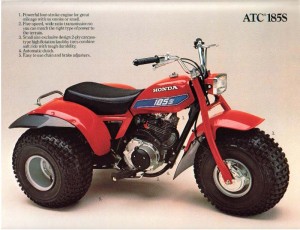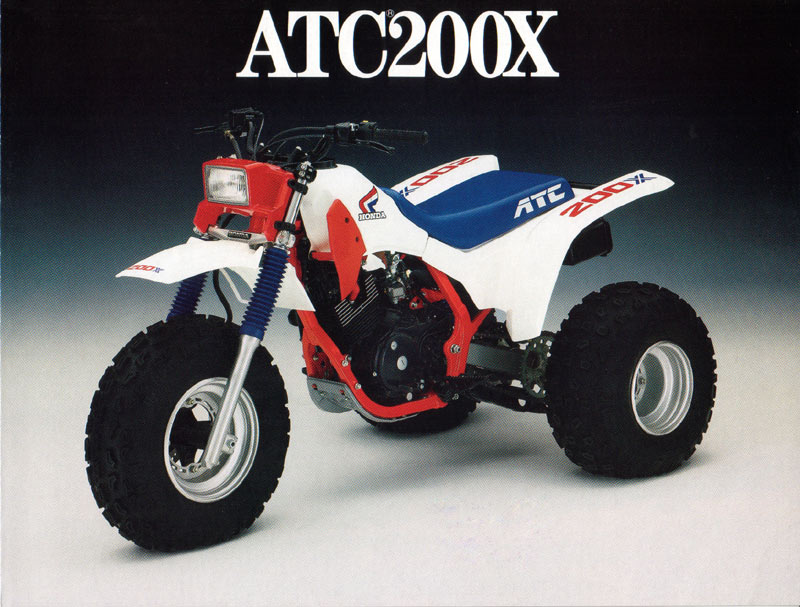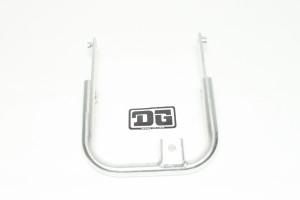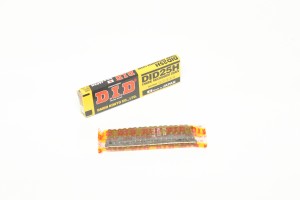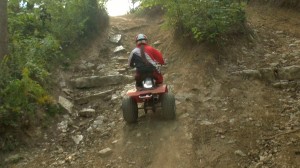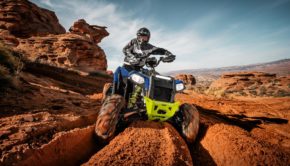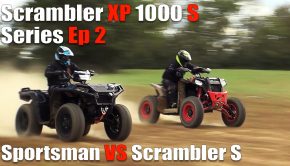1983-1987 Honda ATC200X Classics Test: WITH VIDEO
A model for the industry to follow.
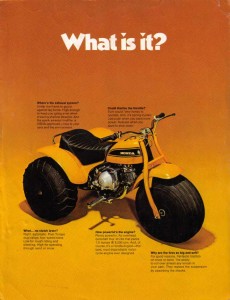
eveloped in the late 1960s to boost dealer sales during the winter months, Honda released their first three-wheeled ATV, the US90 in 1970.
There has perhaps never been a sport ATV more perfect for its time than the Honda ATC200X. It was the ultimate fun machine for the masses. For many, it became the machine of choice for racing. For a select few, it paved the way for racing careers of legendary status.
Developed in the late 1960s to boost dealer sales during the winter months, Honda released their first three-wheeled ATV, the US90 in 1970. The vehicle was unique in its ability to slowly pick its way through rough or challenging terrain without the need to carry momentum like a dirt bike. In 1971, the US90 was rebadged the All-Terrain Cycle or ATC90. In 1979, the ATC90 was replaced by the marginally improved ATC110.
In 1980, Honda released the ATC185, which was built for utility and recreational enthusiasts. In 1981, the ATC185 split into two segments. First, there was the work-focused ATC200, which later led to the 200M, Big Red 200 and later the Big Red 250. The other new machine for 1981 was ATC185s. While it retained some capability as a work machine, the 185s featured enhanced performance for the recreational rider. The 185s shared its engine with the original ATC185 although it featured a more compact chassis, redesigned plastic, and lighter, three-in. smaller 22” tires. It offered the rider a lighter, more nimble and zippier accelerating machine to play around on. In 1982, the 185s remained as the most sporting, four-stroke ATV on the market. Recreational enthusiasts also had the two-stroke options, the Yamaha Tri-Moto 125 and 175.
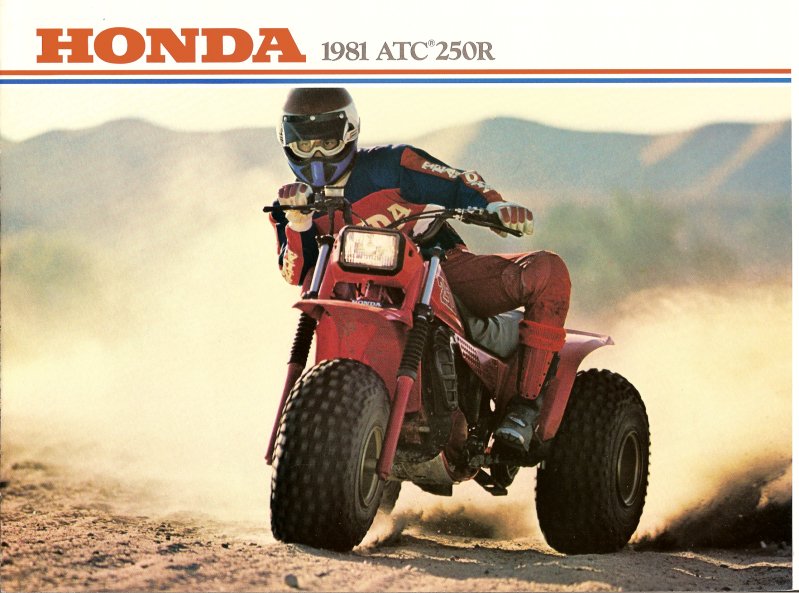
For competitors, the 250R was a machine you could buy from your local Honda dealer and go racing in a sport currently dominated by custom built one off machines.
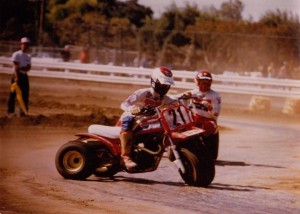
Racers Curtis Sparks, and Tommy Gaian remained in the 180 or 200cc class in 81 and 82 cleaning up at major events around the country on custom-built Nick Nicholson ATC185s with full suspension chassis.
In 1981, Honda also introduced the ATC250R, adding a high-performance model to their line of fun machines. The R was the first mass produced high-performance ATV. Its two-stroke engine wasted any other production ATV of the time and it was the first mass-produced three-wheeler with front and rear suspension. For recreational riders, it provided a level of performance unlike anything else on three wheels. For competitors, the 250R was a machine you could buy from your local Honda dealer and go racing in a sport currently dominated by custom built one off machines. Thanks to the release of the 250R, the racing scene rapidly grew across the country.
With the release of the 250R, many top racers made the jump from the once dominant 180cc class to the 250s. Racers Curtis Sparks, and Tommy Gaian remained in the 180 or 200cc class in 81 and 82 cleaning up at major events around the country on custom-built Nick Nicholson ATC185s with full suspension chassis. Despite their success, the 185s didn’t really take the racing world by storm. In 1981-1982, full suspension was nearly mandatory to compete at a higher level and the stock 185s lacked suspension. Mildly modified and custom-built 185s ran against custom-built, feather weight, full suspension ATC90s and 110s built to 180cc. Two-stroke, Yamaha Tri-Moto 175s were being converted to full suspension by companies like 3B Lightning and Pro Tec. There were also a number of dirt bike based three-wheeler hybrids, like the Yamaha backed, YZ powered, 3B Lightnings raced by Steve Wright and Bob “Ace” Williams.
With the 1982 ATC200 and 200E, “Big Red” designed for work, and the ATC110 and 70 focused on recreation, Honda knew they needed something besides the 185s to bridge the gap between their recreational models and the high-performance 250R. Based on what they’d learned from the ATC250R, 185s, and their successful XR line of four-stroke, off-road, dirt bikes, they developed the first pure-sport, four-stroke ATV, the 1983 Honda ATC200X.
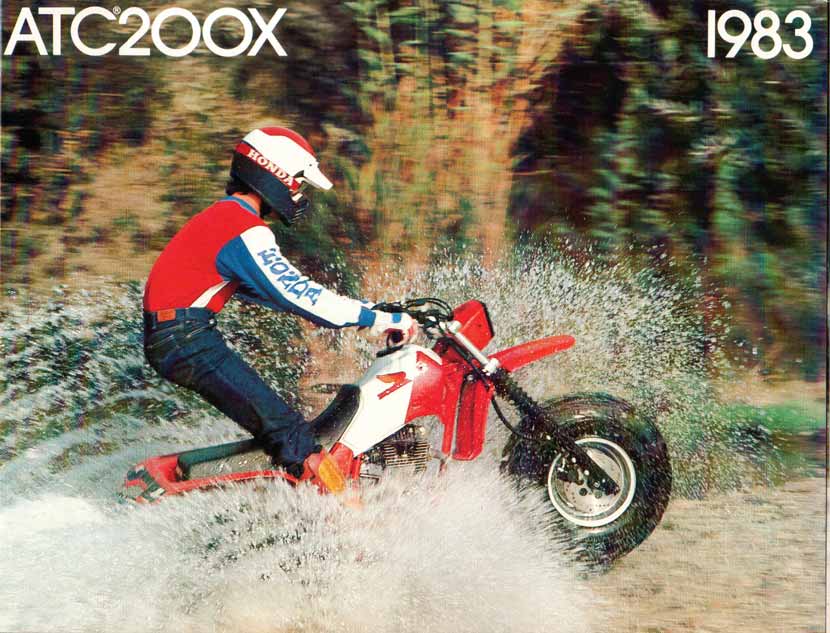
Based on what they’d learned from the ATC250R, 185s, and their successful XR line of four-stroke, off-road, dirt bikes, they developed the first pure-sport, four-stroke ATV, the 1983 Honda ATC200X.
ATC200X 1983-1985
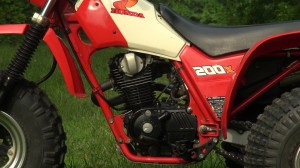
The engine’s biggest performance gain compared to the 185S came from switching from an auto-clutch to a manual-clutch equipped five-speed transmission. As four-stroke ATVs went, the 200X’ engine was high-performance for its time
The 200X’ two-valve, SOHC engine was based on the 185s’ with a focus on increased performance. Displacement was bumped up from 180 to 192cc and compression was increased from 8:1 to 9.2:1. The X received a more aggressive cam and a 2mm larger 24mm carburetor. Air was drawn from an intake in the frame mounted high by the steering stem making it a virtual submarine. The engine’s biggest performance gain came from switching from an auto-clutch to a manual-clutch equipped five-speed transmission. As four-stroke ATVs went, the 200X’ engine was high-performance for its time, but was behind the times when it came to engine design, with four-valve heads dating back to the 1970s on some Honda XR dirt bikes.
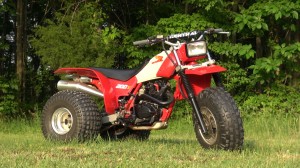
The 200X’ brand new chassis and suspension made it the first fully suspended, mass produced, four-stroke, three-wheeler, and its handling rivaled that of the 81-82 ATC250R.
The 200X’ brand new chassis and suspension made it the first fully suspended, mass produced, four-stroke, three-wheeler, and its handling rivaled that of the 81-82 ATC250R. The 200X featured 41.3” width, a 47.6” wheelbase, and a 27.8” seat height. Its dimensions were pretty similar to the 82 250R’s with the exception of being one inch narrower.
In its time, suspension travel numbers were impressive. The air-adjustable forks delivered 7.3” of travel. Its linkage-less rear suspension featured reservoir-equipped shock with preload and four-way rebound adjustment, yielding 6.7” of travel. Compared to the 1982 250R, the 83 200X had 6/10” more front, and 2.4” more rear suspension travel. The X also received larger diameter forks that flexed notably less.
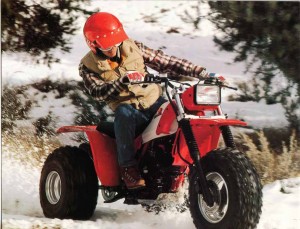
Compared to the 1982 250R, the 83 200X had 6/10” more front, and 2.4” more rear suspension travel. The X also received larger diameter forks that flexed notably less.
22×11-8 tires were used out back. The 23.5×8-11 front tire was 1.5” taller and 3” narrower than that used on the 82 250R to improved directional control and roll more smoothly through bumps. Light and strong aluminum wheels were used at both ends.
The 200X was also the first four-stroke ATV to use hydraulic disc brakes front and rear. Despite its four-stroke engine design, at 282.2 pounds, the 200X was 15.5 pounds lighter than the 82 250R.
The 200X wasn’t the only new high-performance ATC of 1983. Honda also released a completely redesigned ATC250R with a brand new and improved engine, chassis, and suspension. The 83 ATC250R boasted between 8” and 9” of suspension travel at both ends and the new 250R’s performance surpassed the 200X in almost every way. This began the trend of four-stroke sport ATVs lagging behind their two-stroke counterparts in technology and performance
At $1,698 the affordable 1983 200X was an instant success. In its time, it was the perfect machine for less experienced riders, younger brothers, or even the girlfriend. Yet it still provided enough performance that even highly experienced riders couldn’t help having a blast riding one. Honda marketed the 200X as fun and easy to ride with three-wheeled models for the entire family.
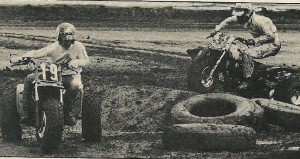
The 200x provided a production based machine on which to race the 200cc class adding to the 200X’ popularity. At major events in 1983, Honda backed 200X pilots Curtis Sparks, Mickey Dunlap, Tommy Gaian, and Steve “too tight” Wright were the guys to beat.
Its arrival provided a production based machine on which to race the 200cc class adding to the 200X’ popularity. At major motocross and TT events in 1983, Honda backed 200X pilots Curtis Sparks, Mickey Dunlap, Tommy Gaian, and Steve “too tight” Wright were the guys to beat. Although the 200X cleaned up on the track, the 200cc class wasn’t a four-stroke only class. 200X pilots received challenges from some two-stroke and other four-stroke hybrids. However, Honda had the fastest racers and sheer numbers on their side.
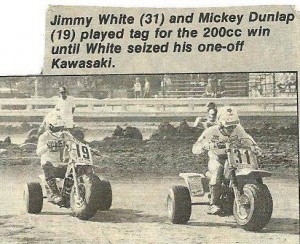
In 1984, Kawasaki released the high-performance, two-stroke, Tecate 250 to challenge Honda’s totally redesigned 1983 ATC250R. It didn’t take long for Factory Kawasaki to sleeve down the Tecate’s engine and introduce lightning fast racers Jimmy White, Chris White into the 200cc class
In 1984, Kawasaki released the high-performance, two-stroke, Tecate 250 to challenge Honda’s totally redesigned 1983 ATC250R. Seeing another opportunity to showcase their product, it didn’t take long for Factory Kawasaki to sleeve down the Tecate’s engine and introduce lightning fast racers Jimmy White, Chris White, and a number of others into the 200cc class to challenge the X. It didn’t take long for aftermarket companies like Selvys Performances, CT Racing, and North West Sleeve to get into the business of turning Honda and Kawasaki 250s into 200s. Tricky Dicks build hybrid machines, converting 190cc Cagiva WMX250 dirt bikes into three-wheelers to contest the 200cc class. Small Minnesota based manufacturer, Tiger, fired up in 1984, doing limited productions of various displacement Rotax powered, two-stroke three-wheelers, including a 200. Not content to watch the 200cc class slip away, Honda built Steve Wright, a totally non-production based, full Factory Worcs ATC200R two-stroke, one of the most custom and expensive machines of the time.
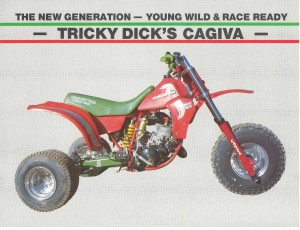
Tricky Dicks build hybrid machines, converting 190cc Cagiva WMX250 dirt bikes into three-wheelers to contest the 200cc class.
The influx of sleeved down 250s, conversion, and small production two-strokes into the 200cc class made it difficult for the popular 200X-based machines to remain competitive. To remedy this, most racing events added a 200cc four-stroke class for the 1985 season, where racers Curtis Sparts and Mickey Dunlap ruled the circuit. This not only created an additional competitive class, it also helped make racing more interesting by helping keep the machinery more diverse, something missing from today’s racing.
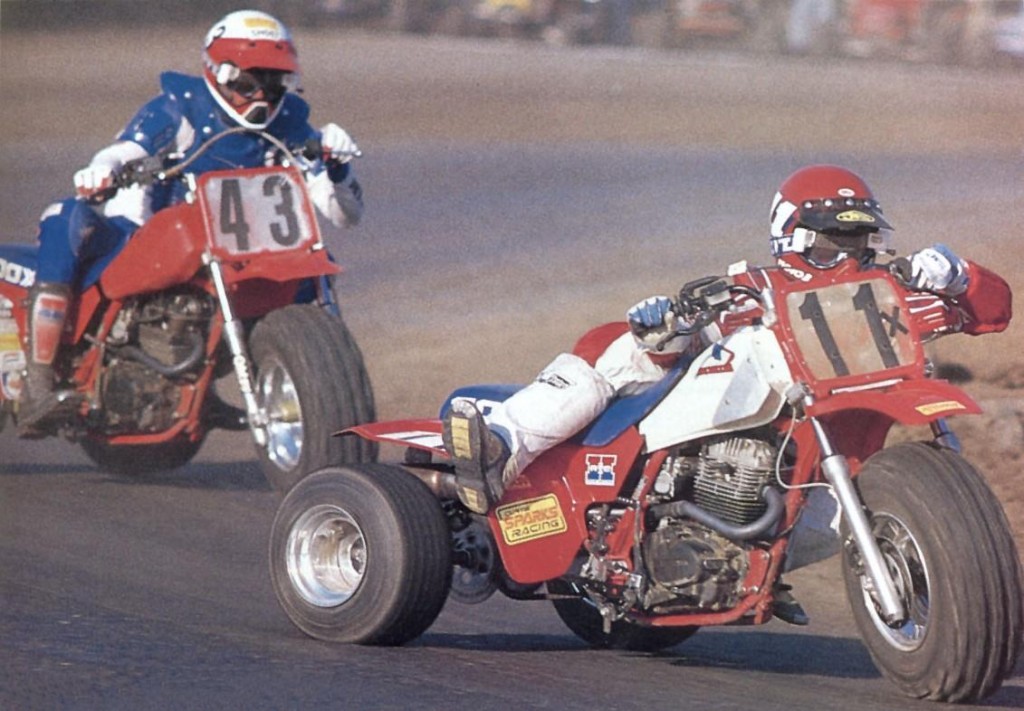
The influx of sleeved down 250s, conversion, and small production two-strokes into the 200cc class made it difficult for the popular 200X-based machines to remain competitive. To remedy this, most racing events added a 200cc four-stroke class for the 1985 season,
ATC200X 1986-1987
Throughout the early and mid-1980s, Honda’s R&D team was working at a pace never seen before or since in the sport ATV industry. After releasing a completely new ATC250R in 1983, they did it again in 1985. In 1985, Honda also released the high-performance, four-stroke ATC350X whose engine was the largest displacement found in a mass produced ATV. Arriving late in the three-wheeler era, the 350X never really caught fire with the racing world like the 200X, which had already established a strong following. With a brand new 250R and 350X in 1985, 200cc class riders and racers were overdue for an updated 200X, which Honda delivered in 1986.
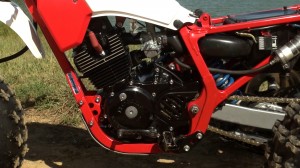
The frame was switched from a round tube to a boxed tube design for increased strength and rigidity. The 86 was widened 1.2” to 43.5” wide while the seat was raised 9/10” to 28.7”.
For 1986, the ATC200X was brand new from the ground up. The frame was switched from a round tube to a boxed tube design for increased strength and rigidity. The 86 was widened 1.2” to 43.5” wide while the seat was raised 9/10” to 28.7”. New suspension components featured revised settings and increased wheel travel, up 3/10” front and 9/10” rear to 7.6” at both ends. A new swingarm brought with it Honda’s easy-to-adjust round-housing chain adjustment, replacing the much more convoluted setup from previous years. The rear tires went from a 22×11-8 to a 22×10-9, reducing the tires’ profile for improved handling.
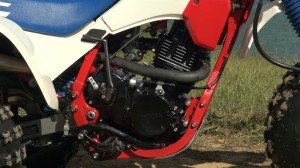
The 86 engine featured increased horsepower and torque, although it retained a relatively low-tech two-valve head design.
The 86 engine featured increased horsepower and torque, although it retained a relatively low-tech two-valve head design. Displacement was increased from 192cc to 199cc, thanks to an increase in stroke from 57.8mm to 60mm. A switch to a six-speed transmission tightened up gear ratios on the little thumper and a 24mm Keihin Carburetor delivered the gas.
By 1986, the 200cc class was shrinking with a number of competitors switching to the new Suzuki 250 Quad Racer and Honda TRX250R four-wheelers. Mickey Dunlap tried racing the 86 200X at a National Motocross event in Washington due to its superior handling over the 83-85 model. However, the generation 1 200X engine had the capability to make around 10% more horsepower in a race-ready state of tune. Although the 85-86 model produced more horsepower out of the box, both Dunlap and Sparks raced the generation 1 200X throughout most of the 86 season due to its ability to produce more horsepower in race trim than the newer model.
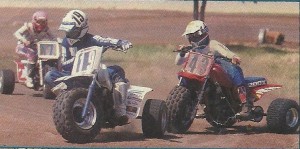
Although the 85-86 model produced more horsepower out of the box, both Mickey Dunlap, (19) and Curtis Sparks, (43) raced the generation 1 200X throughout most of the 86 season due to its ability to produce more horsepower in race trim.
With individuals unwilling to accept personal responsibility for their decisions and actions, lawsuits were mounting against the three-wheeler industry from injured riders; as a huge leader in sales, Honda was especially affected. By 1986, the inevitable end to three-wheelers was apparent. The 200X remained as the only sport three-wheeler in Honda’s lineup for 1987. With the signing of the consent decree that year, the major manufacturers agreed to stop selling three-wheeled ATVs in the United States, and so production of the 200X came to an end.
As a machine with such a rich history, that’s still being enjoyed by many riders today, the Honda ATC200X is a Classic machine we knew we had to put to the test.
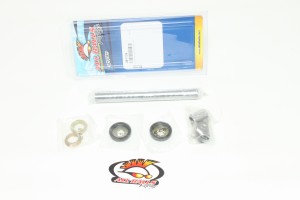
To ensure a wobble free ride, we installed a set of new bearings from All Balls in the swingarm, axle carrier, head tube, and front wheel hub.
Test Prepping
For our modern-day test of the 200X, we had both generations represented. First, we had a 1984 with some minor restorations and updates to bring it up to review worthy status in nearly stock trim. We also had a 1986 200X, which was mostly stock with the exception of wheel spacers, different tires, exhaust and a hotter cam. It was basically the equivalent of that one might have raced at the local level back in the day.
Our 84 model was kept closer to the level of performance one would experience right off the dealer’s showroom floor. To ensure a wobble free ride, we installed a set of new bearings from All Balls in the swingarm, axle carrier, head tube, and front wheel hub.
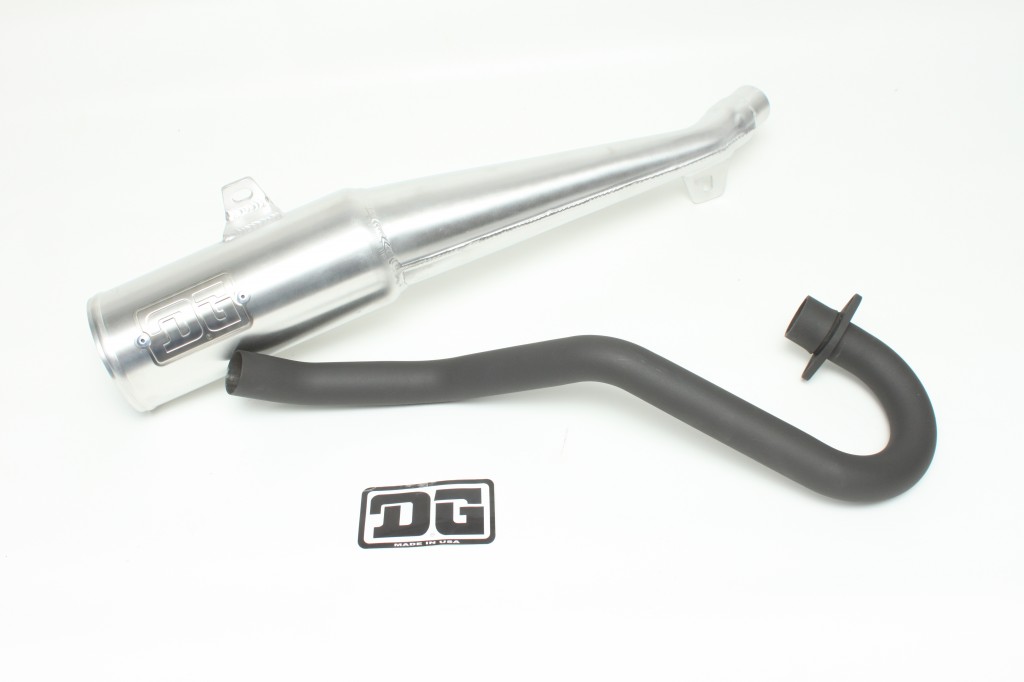
Replacing the ratty looking stock exhaust was a sharp looking, meaner sounding, and better performing DG Performance RCM aluminum silencer and steel head pipe.
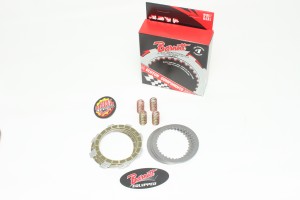
Our X’s clutch pull and power transfer was made light, smooth, and like new thanks to a new clutch cable and clutch kit from Barnett
For the engine, a brand new cam chain from D.I.D. quieted its top-end rattles. Our X’s clutch pull and power transfer was made light, smooth, and like new thanks to a new clutch cable and clutch kit from Barnett including new springs, metal plates, and Kevlar friction plates. Replacing the ratty looking stock exhaust was a sharp looking, meaner sounding, and better performing DG Performance RCM aluminum silencer and steel head pipe. To keep power as close to stock as possible in spite of the better performance DG exhaust, we left the airbox lid installed keeping the intake side more restrictive.
From Rocky Mountain ATV, a Primary Drive 520 O-ring chain and steel sprockets with stock 13/40 gearing freshened up the drivetrain, while Tusk brake pads helped bring braking performance back to life. A set of trimmed down Renthal, Vintage Desert Bend handlebars provided the wide clamping area needed for the 200X’ bar clamps. Renthal’s medium compound, Full Diamond, ATV grips are easy on the hands and easy to hold on to. We swapped the overweight trail tires that came on our 3rd owner 200X for a set of size, weight, and era-appropriate 22×11-8, 2-ply, knobby tires, providing performance similar to the stock tires. Add in some fresh paint here and there and wipe the entire machine down with Maxima SC1, “new bike in a can”, and our 1984 ATC200X was ready to be put to the test.
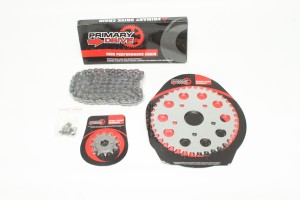
From Rocky Mountain ATV, a Primary Drive 520 O-ring chain and steel sprockets with stock 13/40 gearing freshened up the drivetrain. Tusk brake pads helped bring braking performance back to life.
We took our 84 ATC100X and met up with test rider, Rob Ray, along with Shannon Roberts and his 86 200X at Haspin Acres, in Laurel, Indiana. Haspin Acres is the home of Trikefest, the largest annual gathering of three-wheeler enthusiasts in the world, offering the perfect mix of terrain to put these machines to the test.
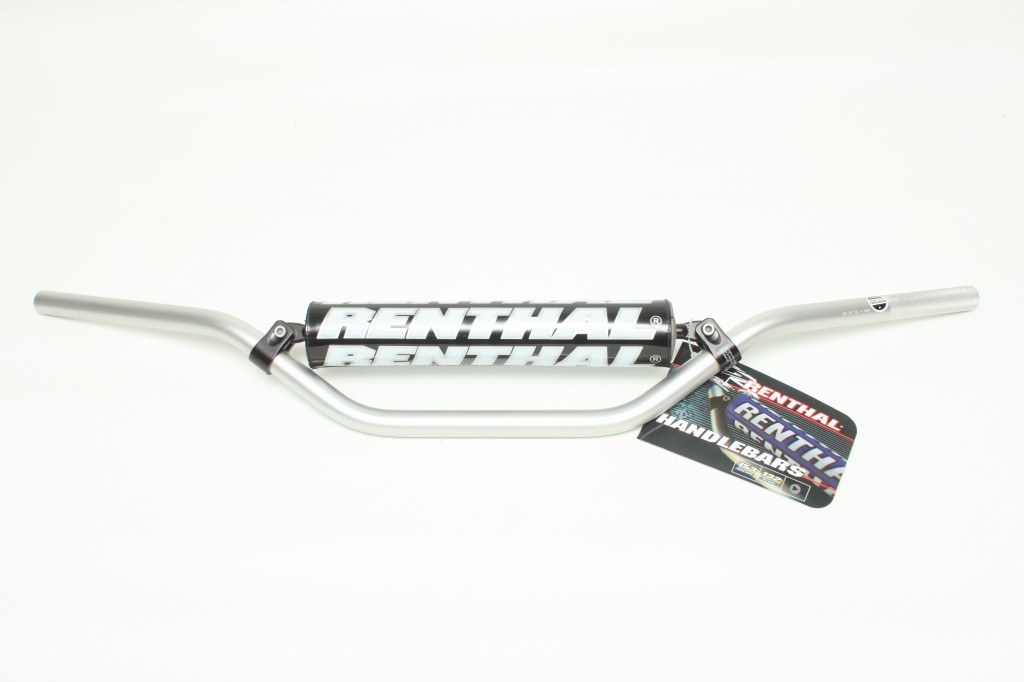
Renthal, Vintage Desert Bend handlebars provided the wide clamping area needed for the 200X’ bar clamps. Renthal’s medium compound, Full Diamond, ATV grips are easy on the hands and easy to hold on to.
The Test
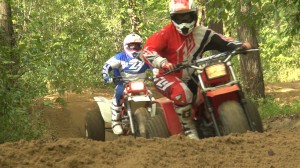
Compared to riding a modern ATV, both machines feel a little on the small side. We could see these machines being a great fit for younger and smaller riders, which makes sense as they were originally recommended for riders age 14 and up.
With our 1984 model closest to stock, we are primarily focusing on evaluating its performance, while contrasting between the machines when possible. The 200X is easy to kick over. Cold starts are not a problem; however, the engine becomes temperamental when hot. The 86 model’s higher mounted kick starter prevents you from stomping the ground at the bottom of the stroke.
Compared to riding a modern ATV, both machines feel a little on the small side. We could see these machines being a great fit for younger and smaller riders, which makes sense as they were originally recommended for riders age 14 and up. As was typical of three-wheelers, the seat height feels rather low, keeping your center of gravity down for corners while providing a real leg workout on rough tracks or trails where you often transfer from sitting to standing. The cockpit on the 86 model is a bit more spacious. Both machine’s footpegs are rather narrow and uncomfortable.
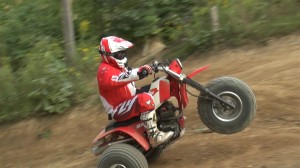
by Honda placing the best part of the power low in the RPMs, they really made the most of the engine’s simplistic design. Adding the closer ratio, six-speed transmission to the 1986-87 models made its engine feel even more effective.
The engine’s magic starts happening right off idle. The little four-stroke delivers more torque than you might expect from an engine of this size. Despite producing a modest 10.5hp in stock trim, according to Four Stroke Tech, the engine’s outstanding low-end torque, low rolling resistance of a three-wheeler, and light 282.2 pound weight let the 200X get moving pretty quickly. The X engine feels virtually unstoppable chugging its way up steep hills as long as you’re not in deep sand. The engine will happily plug along a gear high, allowing you to casually cruise along at low RPMs. When it’s time to throw it sideways and rip out of turns, shift down a gear.
Good midrange power allows you to carry slides out of corners and keeps things entertaining as the trail opens up. The 200X is definitely fast enough to have fun with, even for experienced riders, especially when you have two Xs dice it out on. While you might struggle to keep up with an ATC250R or newer performance four-wheeler on wide open spaces, both of our Xs could easily smoke the 300cc, CVT-equipped, four-wheeler we had on hand and would probably give a 250X or 300EX a run for their money.
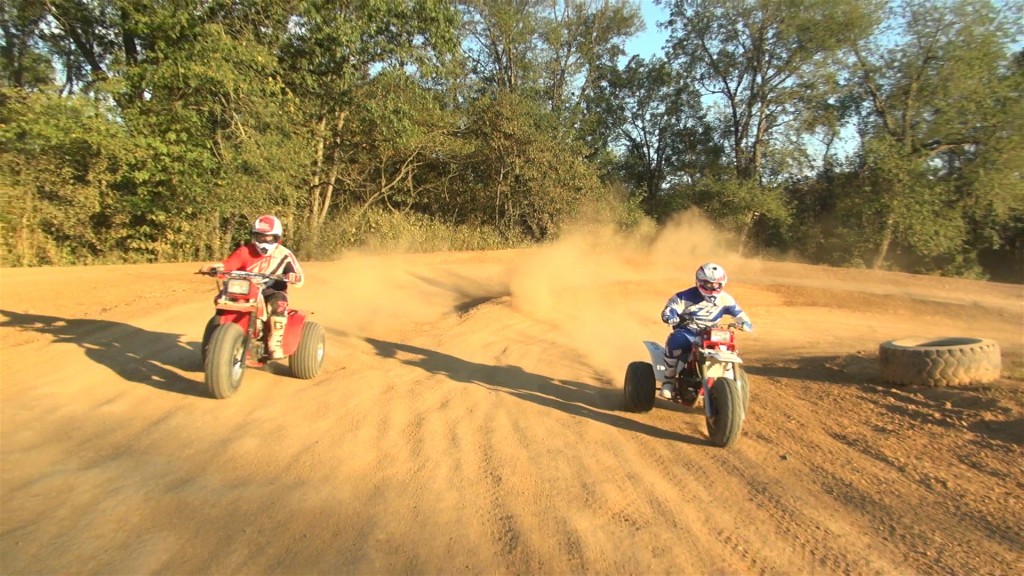
Good midrange power allows you to carry slides out of corners and keeps things entertaining as the trail opens up.
Midrange power isn’t quite as impressive as the low-end and by the time you reach the top third of the RPM range, it’s time to upshift. With a two-valve head, the 200X doesn’t rev especially fast or pull very high in the RPMs, so by Honda placing the best part of the power low in the RPMs, they really made the most of the engine’s simplistic design. Adding the closer ratio, six-speed transmission to the 1986-87 models made its engine feel even more effective. We found shifting pretty smooth and precise on both models despite their age.
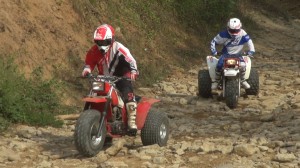
The X suspension takes out the square-edged bumps that could really unsettle a fully rigid three-wheeler. It’s plush and clearly focused on trail riding and lighter riders.
The 200X’ suspension was good in its time and does an okay job by today’s standards. Whether you’re cruising along or hammering down the trail, the X suspension takes out the square-edged bumps that could really unsettle a fully rigid three-wheeler. It’s plush and clearly focused on trail riding and lighter riders, although our shocks had undoubtedly softened a bit with time. You’ll quickly discover the suspension’s limits hammering through whoops although both machines remained pretty manageable for our experienced pilots. When it came to jumping, precise landings were a must, even on smaller, forgiving doubles; overshoot it or come up short, and the suspension bottoms harshly at both ends with the rear shock seeming to find its limits first. In rough chop, big nits, and jump landings, the 86-87’s suspension enjoyed a small advantage in performance, finding the limits of their travel less often. While the engines still provide a high fun factor even by today’s standards, its suspension feels overly soft and dated compared to a more modern entry-level sport ATV like a Yamaha Raptor 250 or Honda 300EX.
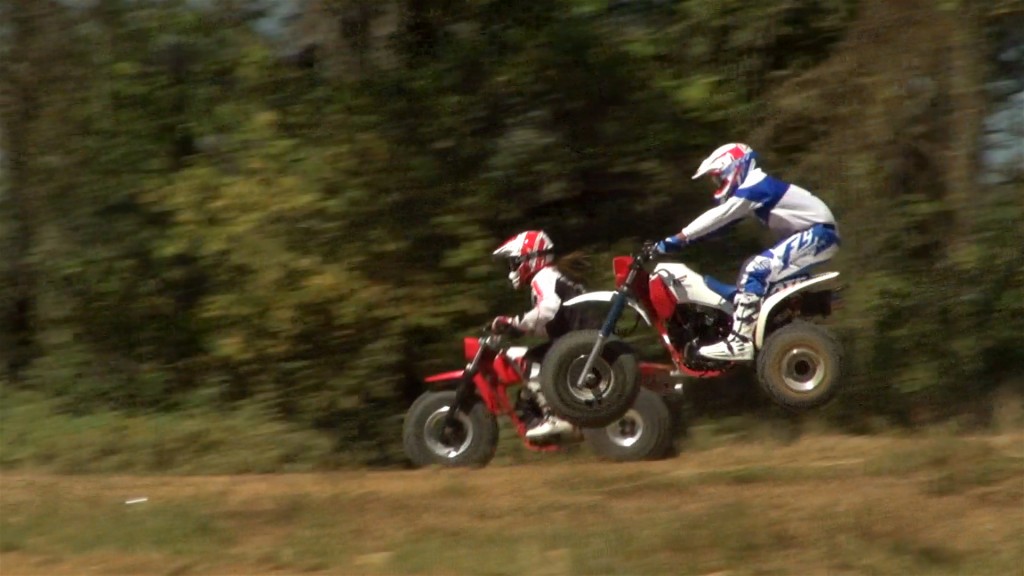
Even on smaller, forgiving doubles; overshoot it or come up short, and the suspension bottoms harshly at both ends
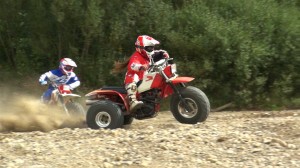
It takes a lot of rider skill to make a three-wheeler handle well. If you have that skill, the ATC200X is a good handling three-wheeler.
It takes a lot of rider skill to make a three-wheeler handle well. If you have that skill, the ATC200X is a good handling three-wheeler. Steering is pretty predictable with a little front-end push, perhaps due to our taller rider’s weight being carried too far back on the machine. There was enough front-end snap available to help crank the rear end around for slides, yet at higher speeds the steering feels pretty predictable and manageable compared to other three-wheelers, of course.
Whether you’re pitching it sideways in the loose stuff or railing a berm hooked up, with its low seat height and lots of body English from the rider, the 200X can get through turns pretty quickly for its stock 41.3-inch width on the 84 model. When the trail turns uphill, the 200X is a capable climber. Its high-torque engine, low center of gravity, and 47.6” wheelbase allow you to crawl up hills with less body English than you might expect, especially from a machine that’s so willing to wheelie on demand.
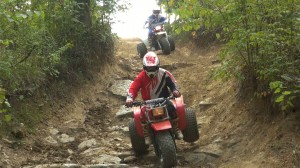
A three-wheeler’s handling is most sketchy under hard braking or on a steep descent. With its narrower width, the 200X really keeps you on your toes on rough, steep, downhills.
A three-wheeler’s handling is most sketchy under hard braking or on a steep descent. With its narrower width, the 200X really keeps you on your toes on rough, steep, downhills. As a smaller machine, the instability problem grows with taller, heavier riders raising the overall center of gravity of both man and machine.
With compact dimensions and light, nimble handling, the 200X seems most in its element on tight, twisty trails, the same areas where its engine feels most impressive. The good handling manners of this three-wheeler are, undoubtedly, partly due to the fact that the engine is so smooth, delivering its goods low in the RPMs, with no surprises later on to get you in over your head.
With the generation 1 machine weighing in at 282.2 pounds, the single piston caliper, hydraulic disc brakes found on both trikes do a good job of scrubbing off speed, and both thumpers offer a usable amount of engine braking for long, mellow downhills. Other notable details abound on these basic machines including clamp-on filters and airbox lids that can be removed without tools. Even with its very reasonable asking price, Honda managed to use good quality, lightweight, aluminum wheels, and high-quality, plastic bodywork that has resisted cracking for more than three decades. Come to think of it, these entire machines proved to be pretty well engineered and manufacturered. The proof is in the fact that there are still so many readily available on the used market today.
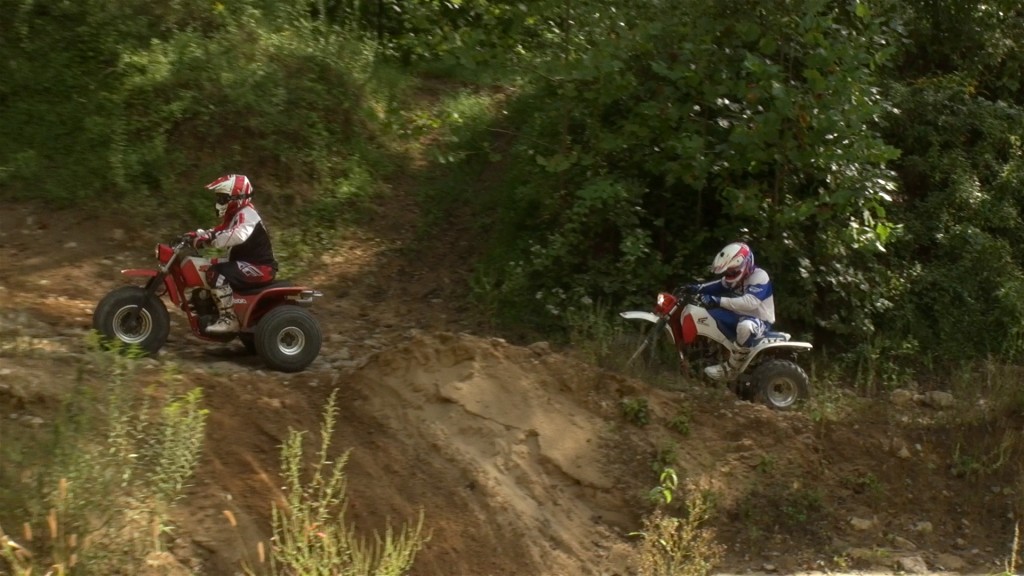
these entire machines proved to be pretty well engineered and manufacturered. The proof is in the fact that there are still so many readily available on the used market today.
Conclusion
The performance of the Honda ATC200X was unlike any production four-stroke ATV before it. Some would say that its balance of affordability, reliability, and, most of all, fun, is unlike anything that’s come along since. Today, the 200X is still putting smiles on the faces of first time riders, and riders who have ridden or raced them for decades. Honda’s ATC200X was a landmark machine that has entertained generations, and although it’s a small machine by today’s standards, it played a big role in the history of the ATV and ATV racing.
With lots of parts still available on the new and used market and so many good running 200Xs still out there for under a grand, even today, it’s hard to have more fun for the money than a 200X provides. That’s why we feel the 1983-1987 Honda ATC200X is truly a Classic machine worth picking up and restoring.
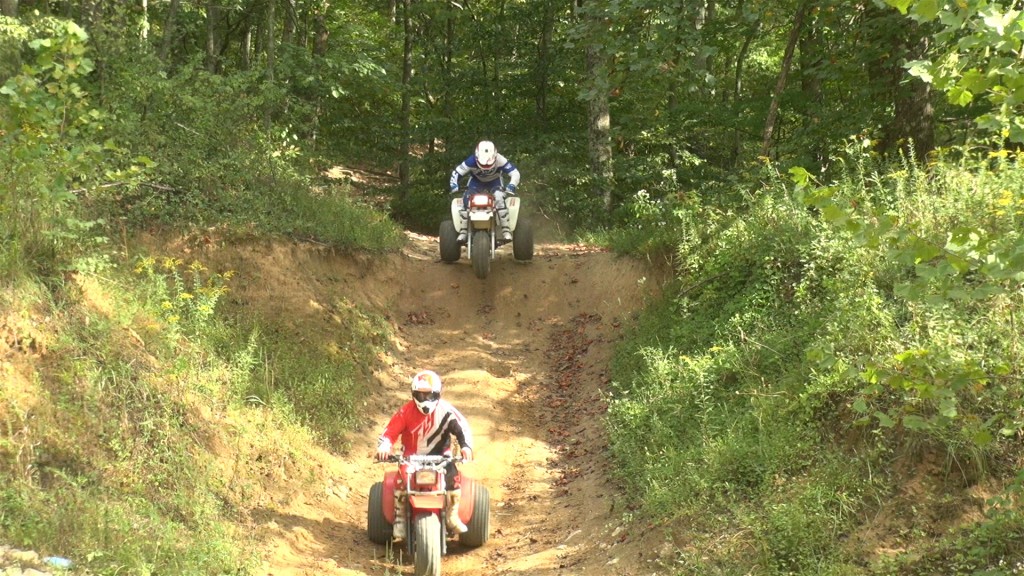
With lots of parts still available on the new and used market and so many good running 200Xs still out there for under a grand, even today, it’s hard to have more fun for the money than a 200X provides.
Replacement Parts
| Item | Manufacturer/Model | Price |
| Engine | ||
| Exhaust | DG Performance RCM Aluminum sSilencer with Ateel Head Pipe | $249.95 |
| Cam Chain | D.I.D | |
| Clutch | Barnett Dirt Digger Clutch Kit with Springs, Friction, and Steel Clutch Plates | $72.51 |
| Drive | ||
| Chain | Primary Drive 520 O-Ring Chain | $36.50 |
| Sprocket Front | Primari Drive 13 Tooth Steel | $8.99 |
| Sprocket Rear | Primary Drive 40 Tooth Steel | $19.99 |
| Brakes | ||
| Brake Pads F/R | Tusk | $16.99 ea |
| Controls | ||
| Handlebars | Renthal 7/8 Inch Desert Vintage Bend | $79.95 |
| Grips | Renthal Full Diuamond ATV Grips | $12.95 |
| Clutch Cable | Barnett Custom Clutch Cable | $58.00 |
| Protection | ||
| Grab Bar | DG Alloy Series | $69.95 |
| Replacement Parts | ||
| Front Wheel Bearings | All Balls Racing | $17.31 |
| Rear Wheel Bearings | All Balls Racing Axle Bearings | $24.53 |
| Seingarm Bearings | All Balls Racing | $49.75 |
| Steering Bearings | All Balls Racing | $41.10 |
| Manufacturer | Website | |
| All Balls Racing | http://www.allballsracing.com/ | |
| Barnett | http://www.barnettclutches.com/ | |
| DG Perfomance | http://dgperformance.com/ | |
| DID | http://didchain.com/ | |
| Primary Drive | https://www.rockymountainatvmc.com/ | |
| Renthal | http://renthal.com/ | |
| Tusk | https://www.rockymountainatvmc.com/ |
1983-1987 ATC200X
Summary: The performance of the Honda ATC200X was unlike any production four-stroke ATV before it. Some would say that its balance of affordability, reliability, and, most of all, fun, is unlike anything that’s come along since. Today, the 200X is still putting smiles on the faces of first time riders, and riders who have ridden or raced them for decades. Honda’s ATC200X was a landmark machine that has entertained generations, and although it’s a small machine by today’s standards, it played a big role in the history of the ATV and ATV racing. With lots of parts still available on the new and used market and so many good running 200Xs still out there for under a grand, even today, it’s hard to have more fun for the money than a 200X provides.


